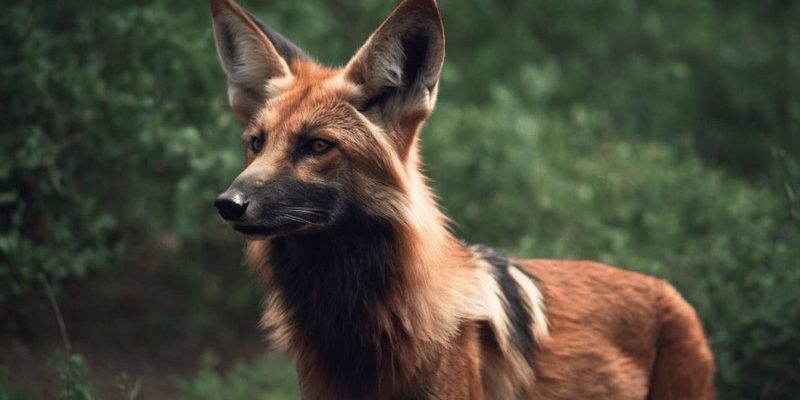
Yet, despite its unique appearance and fascinating behavior, many people have misconceptions about the maned wolf. Some folks think it’s a type of wolf, while others might confuse it with the fox family. Let’s lift the curtain on this intriguing creature and clear up some common myths and misconceptions about it, making sure to see the maned wolf for what it truly is.
The Maned Wolf is a True Wolf
You might be surprised to learn that the maned wolf is not a true wolf at all. While it carries “wolf” in its name, it belongs to a unique genus called *Chrysocyon*, meaning “golden dog.” Here’s the thing: the maned wolf’s closest relatives are actually foxes, not wolves. Its long legs and large ears help it navigate the tall grasslands of its native habitat, which includes parts of Brazil, Paraguay, and Argentina.
Think of it like an awkward teenager. It doesn’t quite fit into labels we might want to apply. Instead of being a “wolf” or a “fox,” the maned wolf stands alone in its own niche. This distinction is important because it sheds light on its unique adaptations and behaviors that are quite different from what you’d expect from either wolves or foxes.
Maned Wolves Live in Packs
Another common myth is that maned wolves are social animals that live in packs, just like their wolf cousins. While many wolves rely on teamwork for hunting and raising their young, maned wolves are primarily solitary. They prefer to roam around their territories on their own, which can span several square miles, especially when they’re looking for food.
This doesn’t mean they’re antisocial, though! They do come together during the breeding season, and mothers raise their pups independently. In fact, the mother will often teach her young ones essential survival skills, much like a coach guiding an athlete in training. So, while they may not hold pack meetings, their parenting structure is a crucial part of their species’ success.
Maned Wolves are Dangerous Predators
Many people think that any animal with “wolf” in its name must be a fierce predator, but that isn’t the case with the maned wolf. They’re not dangerous to humans or livestock. Maned wolves have a diet that’s quite atypical for a creature of their name. Instead of focusing on large prey, they tend to munch on a variety of foods, including fruits, small mammals, and insects.
Here’s a fun fact: one of their favorite snacks is the lobeira fruit, also known as the “wolf apple.” This berry is not just a treat; it serves as an important energy source for them. Imagine being able to live off the land while snacking on berries and little critters—sounds like a dreamy life, doesn’t it?
The Maned Wolf Howls Like Other Wolves
If you’ve ever listened to a wolf howling under a full moon, you might expect maned wolves to do the same. However, they have a different vocalization style altogether. Instead of the deep, haunting howls we associate with traditional wolves, maned wolves produce a unique sound often described as a series of high-pitched barks and yips.
You might say their calls sound more like a sitcom’s quirky character than a fierce hunter. This vocal style helps them communicate over long distances in the open grasslands. So, while you’re unlikely to hear a maned wolf’s howl echoing through the night, their sounds are perfectly suited to their habitat.
Maned Wolves Are All the Same Color
When you think of maned wolves, the reddish-brown color might be the first thing that comes to mind. However, they can actually sport a range of colors, depending on various factors like location and genetics. While many have that classic reddish hue, some can appear more golden or even have darker patches.
This diversity in coloration can help them blend into their surroundings. Imagine them playing dress-up with nature’s palette. The variability not only adds to their charm but also plays a role in their survival by offering them better camouflage against predators and during hunts.
Maned Wolves Are Common and Not Threatened
You might assume that, with their fascinating traits, maned wolves are plentiful across their native range. Unfortunately, this isn’t the case. They are considered near threatened due to habitat loss and fragmentation caused by agriculture and urbanization.
Here’s where it gets a little heartbreaking. As humans expand their territories, these beautiful creatures find their homes shrinking and their food sources dwindling. Conservation efforts are underway to preserve their habitats and ensure that future generations can enjoy the beauty of the maned wolf. It’s like a community coming together to save a cherished story from disappearing.
So now you know—the maned wolf is an intriguing creature that deserves our respect and understanding. By dispelling these common myths and misconceptions, we can appreciate this unique animal even more. Whether it’s how they thrive in solitude, their playful vocalizations, or their varied colors, the maned wolf is much more than its name suggests.
As we continue to explore and learn, let’s advocate for the preservation of their habitats so these remarkable beings can roam the savannas for years to come. It’s up to us to appreciate and protect the wonders of nature, and the maned wolf is certainly one of them!

